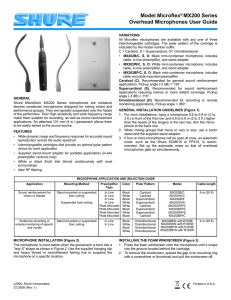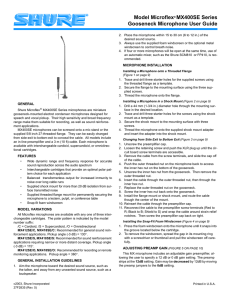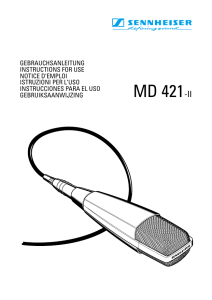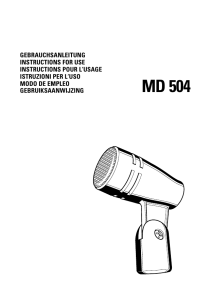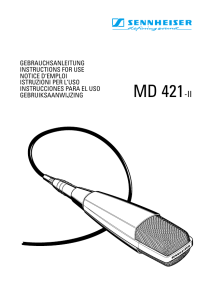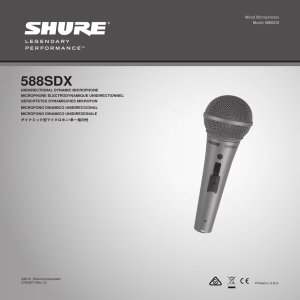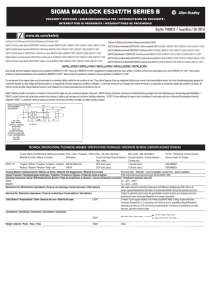Microflex MX200 Series Overhead Microphone User
Anuncio
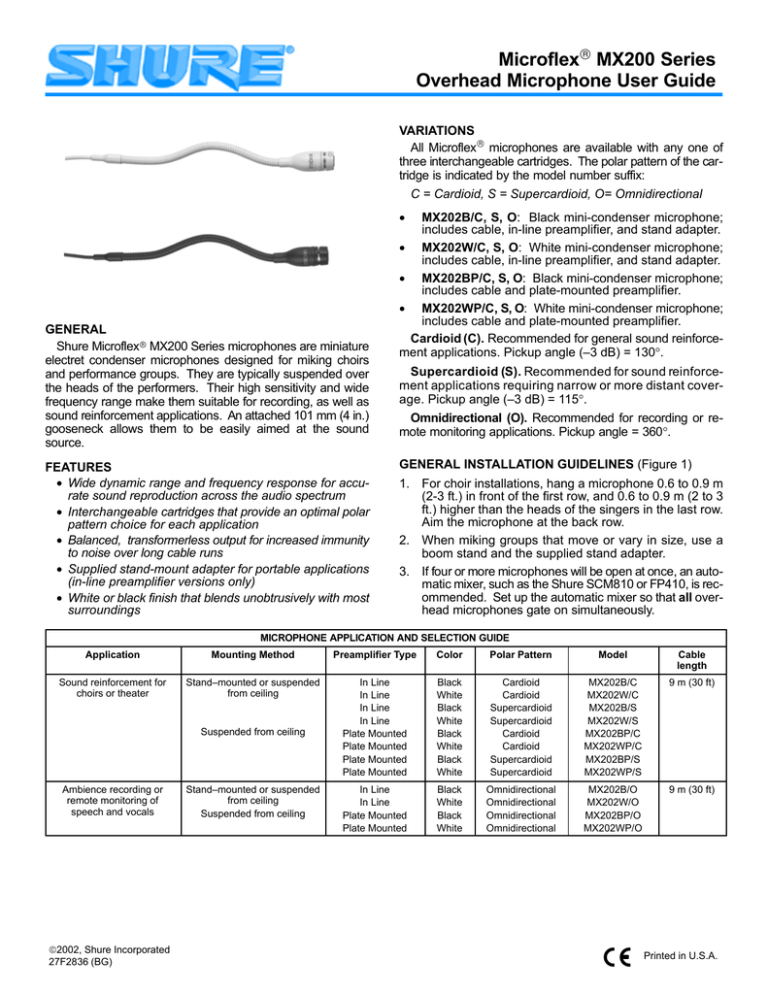
Microflex MX200 Series Overhead Microphone User Guide VARIATIONS All Microflex microphones are available with any one of three interchangeable cartridges. The polar pattern of the cartridge is indicated by the model number suffix: C = Cardioid, S = Supercardioid, O= Omnidirectional • GENERAL Shure Microflexr MX200 Series microphones are miniature electret condenser microphones designed for miking choirs and performance groups. They are typically suspended over the heads of the performers. Their high sensitivity and wide frequency range make them suitable for recording, as well as sound reinforcement applications. An attached 101 mm (4 in.) gooseneck allows them to be easily aimed at the sound source. FEATURES • Wide dynamic range and frequency response for accurate sound reproduction across the audio spectrum • Interchangeable cartridges that provide an optimal polar pattern choice for each application • Balanced, transformerless output for increased immunity to noise over long cable runs • Supplied stand-mount adapter for portable applications (in-line preamplifier versions only) • White or black finish that blends unobtrusively with most surroundings MX202B/C, S, O: Black mini-condenser microphone; includes cable, in-line preamplifier, and stand adapter. • MX202W/C, S, O: White mini-condenser microphone; includes cable, in-line preamplifier, and stand adapter. • MX202BP/C, S, O: Black mini-condenser microphone; includes cable and plate-mounted preamplifier. • MX202WP/C, S, O: White mini-condenser microphone; includes cable and plate-mounted preamplifier. Cardioid (C). Recommended for general sound reinforcement applications. Pickup angle (–3 dB) = 130°. Supercardioid (S). Recommended for sound reinforcement applications requiring narrow or more distant coverage. Pickup angle (–3 dB) = 115°. Omnidirectional (O). Recommended for recording or remote monitoring applications. Pickup angle = 360°. GENERAL INSTALLATION GUIDELINES (Figure 1) 1. For choir installations, hang a microphone 0.6 to 0.9 m (2-3 ft.) in front of the first row, and 0.6 to 0.9 m (2 to 3 ft.) higher than the heads of the singers in the last row. Aim the microphone at the back row. 2. When miking groups that move or vary in size, use a boom stand and the supplied stand adapter. 3. If four or more microphones will be open at once, an automatic mixer, such as the Shure SCM810 or FP410, is recommended. Set up the automatic mixer so that all overhead microphones gate on simultaneously. MICROPHONE APPLICATION AND SELECTION GUIDE Application Mounting Method Preamplifier Type Color Polar Pattern Model Cable length Sound reinforcement for choirs or theater Stand–mounted or suspended from ceiling In Line In Line In Line In Line Plate Mounted Plate Mounted Plate Mounted Plate Mounted Black White Black White Black White Black White Cardioid Cardioid Supercardioid Supercardioid Cardioid Cardioid Supercardioid Supercardioid MX202B/C MX202W/C MX202B/S MX202W/S MX202BP/C MX202WP/C MX202BP/S MX202WP/S 9 m (30 ft) In Line In Line Plate Mounted Plate Mounted Black White Black White Omnidirectional Omnidirectional Omnidirectional Omnidirectional MX202B/O MX202W/O MX202BP/O MX202WP/O 9 m (30 ft) Suspended from ceiling Ambience recording or remote monitoring of speech and vocals 2002, Shure Incorporated 27F2836 (BG) Stand–mounted or suspended from ceiling Suspended from ceiling Printed in U.S.A. MICROPHONE INSTALLATION (Figure 2) The microphone is most stable when the gooseneck is bent into a “lazy S” shape as shown in Figure 2. Use the supplied hanging clip and heavy thread or monofilament fishing line to suspend the microphone at a specific location. Maximum SPL (1 kHz at 1% THD, 1 kΩ load) Cardioid: 124.2 dB Supercardioid: 122.7 dB Omnidirectional: 116.7 dB All values +6 dB at 0 gain Equivalent Output Noise (A-weighted) Cardioid: 28.0 dB SPL Supercardioid: 26.5 dB SPL Omnidirectional: 20.5 dB SPL INSTALLING THE FOAM WINDSCREEN (Figure 3) 1. Press the foam windscreen onto the microphone until it snaps into the groove located behind the cartridge. 2. To remove the windscreen, spread the gap in its mounting ring with a screwdriver or thumbnail and pull the windscreen off. Signal to Noise Ratio (referenced at 94 dB SPL) Cardioid: 66.0 dB Supercardioid: 67.5 dB Omnidirectional: 73.5 dB PREAMPLIFIER INSTALLATION Dynamic Range at 1 kΩ Load 96.2 dB Plate-Mount Preamplifier Input Connections 1. Detach the preamplifier housing by removing the two Phillips head screws from the back of the housing. 2. Remove the material from the hole in the center of the cover plate or the center of the preamplifier housing. 3. Cut the cable to the desired hanging length, allowing for a 76 mm to 101 mm (3 to 4 in.) service loop. 4. Clamp the strain relief around the cable and insert the strain relief into the hole. 5. Connect the cable leads to the terminal block (B = Black, R = Red, S = Shield). 100 dB at 0 gain Common Mode Rejection 45.0 dB minimum Preamplifier Output Clipping Level (1% THD) –6.0 dBV (0.5 V) –12 dBV at 0 gain Polarity Positive sound pressure on diaphragm produces positive voltage on pin 2 relative to pin 3 of output connector. Power Requirements 11 to 52 Vdc phantom, 2.0 mA Plate–Mount Preamplifier Output Cable Connections 1. Using professional-quality, two-conductor, shielded microphone cable, thread the output cable from the outside of the preamplifier through the hole with the black bushing. 2. Connect cable to pins as follows: Pin 2 = +, Pin 3 = –, Shield = S. 3. Reattach the preamplifier housing. Environmental Requirements Operating Temperature Range: –18° C to 57° C (0° F to 135° F) Relative Humidity: 0 to 95% Dimensions (Figure 7) CERTIFICATION Eligible to bear CE Marking. Conforms to European EMC Directive 89/336/EEC. Meets applicable tests and performance criteria in European Standard EN55103 (1996) parts 1 and 2, for residential (E1) and light industrial (E2) environments. Installing the In-Line Preamplifier (Figure 4) Use the two supplied mounting clamps to hold the preamplifier in place on a wall or ceiling. Set the length of the cable by cutting it appropriately and using the screw terminal connections inside the preamplifier. The terminals are marked B (black), R (red), and S (shield). NOTE: For technical data by fax, phone 1-800-488-3297 and follow the recorded instructions. For additional technical assistance, phone Shure at (847) 866-2200. In Europe, phone 49-7131-72140. Adjusting Preamp Gain (Figure 5) This MX microphone includes an adjustable gain preamplifier, allowing the user to specify a 12 dB or 0 dB gain setting. The preamp ships at the 12dB setting. Gain may be decreased by 12dB by moving the preamp jumpers to the 0dB setting. Shure, the Shure logo, and Microflex are registered trademarks of Shure Incorporated. SPECIFICATIONS Frequency Response (Figure 9) 50 to 17,000 Hz REPLACEMENT PARTS Omnidirectional Cartridge (Black) . . . . . . . . . . . . . R183B Omnidirectional Cartridge (White) . . . . . . . . . . . . R183W Supercardioid Cartridge (Black) . . . . . . . . . . . . . . . R184B Supercardioid Cartridge (White) . . . . . . . . . . . . . . R184W Cardioid Cartridge (Black) . . . . . . . . . . . . . . . . . . . . R185B Cardioid Cartridge (White) . . . . . . . . . . . . . . . . . . . R185W Snap-Fit Windscreens (Black, 4 per pkg.) . . . RK183WS Preamplifier kit, plate mounted . . . . . . . . . . . . . . RK202PK Stand Adaptor . . . . . . . . . . . . . . . . . . . . . . . . . . . . 65B1752 Polar Pattern (Figure 10) Output Impedance 180 Ω actual (EIA rated at 150 Ω) Sensitivity (At 1,000 Hz, open circuit voltage*) Cardioid: –35.0 dBV/Pa (17.8 mV) Supercardioid: –33.5 dBV/Pa (21.1 mV) Omnidirectional: –27.5 dBV/Pa (42.2 mV) All values –12 dB at 0 gain *1 Pascal = 94 dB SPL 2 Microphone suspendu Microflex série MX200 Guide de l’utilisateur GÉNÉRALITÉS Les Shure Microflex série MX200 sont des microphones électrostatiques conçus pour la prise de son de choeurs et groupes vocaux. Ils sont en général suspendus au–dessus de la tête des artistes. Leur haute sensibilité et large gamme de fréquence permettent de les utiliser pour les enregistrements et la sonorisation de scène. Un col de cygne intégré de 10 cm permet de les orienter facilement vers la source sonore. • MX202B/C, S, O : Mini microphone électrostatique noir avec câble, préampli et adaptateur de pied. • MX202W/C, S, O : Mini microphone électrostatique blanc avec câble, préampli et adaptateur de pied. • MX202BP/C, S, O : Mini microphone électrostatique noir avec câble et préampli monté sur plaque. • MX202WP/C, S, O : Mini microphone électrostatique blanc avec câble et préampli monté sur plaque. Cardioïde (C). Recommandé pour les applications de sonorisation générale. Angle de captage (–3 dB) = 130_. Supercardioïde (S). Recommandé pour les applications de sonorisation exigeant un captage plus étroit ou à plus grande distance. Angle de captage (–3 dB) = 115_. AVANTAGES • Large gamme dynamique et courbe de réponse pour une reproduction précise du son sur tout le spectre audio • Cartouches interchangeables permettant une courbe de directivité optimale pour chaque application • Sortie équilibrée sans transformateur pour une immunité aux bruits accrue avec de grandes longueurs de fil. • Adaptateur de pied inclus permettant l’utilisation à la main (versions à préampli en ligne seulement) • Fini noir ou blanc assurant la discrétion dans la plupart des décors Omnidirectionnel (O). Recommandé pour l’enregistrement ou le captage à distance. Angle de captage = 360_. DIRECTIVES GÉNÉRALES POUR L’INSTALLATION (Figure 1) 1. Pour la prise de son des choeurs, suspendre un microphone à 60 à 90 cm au-dessus du premier rang et à 60 à 90 cm au-dessus de la tête des choristes du dernier rang. Orienter le microphone vers le dernier rang. 2. Pour la prise de son de groupes mobiles ou variables en nombre, utiliser une girafe et l’adaptateur de pied fourni. VARIANTES Tous les microphones Microflex sont offerts avec l’une des trois cartouches interchangeables. La courbe de directivité de la cartouche utilisée dans un micro particulier est indiquée par le suffixe du numéro de modèle : 3. Lorsque quatre microphones ou plus doivent être ouverts simultanément l’usage d’une table de mélange automatique, telle que la Shure SCM810 ou FP410 est recommandé. Régler la table de mélange de façon à ce que tous les microphones suspendus soient activés simultanément. C = Cardioïde, S = Supercardioïde, O= Omnidirectionnelle GUIDE DE SÉLECTION ET D’APPLICATION DES MICROPHONES Application Méthode de montage Micros à préampli Couleur Courbe de directivité Modèle Longueur du câble Sonorisation de choeurs ou de théâtre Sur pied ou suspendu au plafond En ligne En ligne En ligne En ligne Monté sur plaque Monté sur plaque Monté sur plaque Monté sur plaque Noir Blanc Noir Blanc Noir Blanc Noir Blanc Cardioïde Cardioïde Supercardioïde Supercardioïde Cardioïde Cardioïde Supercardioïde Supercardioïde MX202B/C MX202W/C MX202B/S MX202W/S MX202BP/C MX202WP/C MX202BP/S MX202WP/S 9m En ligne En ligne Monté sur plaque Monté sur plaque Noir Blanc Noir Blanc Omnidirectionnelle Omnidirectionnelle Omnidirectionnelle Omnidirectionnelle MX202B/O MX202W/O MX202BP/O MX202WP/O 9m Suspendu au plafond Enregistrement d’ambiance ou contrôle à distance de la voix Sur pied ou suspendu au plafond Suspendu au plafond Branchement du câble de sortie du préampli monté sur plaque 1. Utiliser un câble de microphone blindé à deux conducteurs, de qualité professionnelle. Insérer le câble de l’extérieur du préampli, dans le trou muni d’une bague noire. 2. Brancher le câble comme suit : Broche 2 = +, Broche 3 = –, Blindage = S. 3. Remonter le boîtier du préampli. Branchement d’entrée du préampli monté sur plaque 1. Retirer les deux vis Phillips au dos du boîtier du préampli pour le détacher. 2. Ouvrir le trou pré-perforé du centre du couvercle ou du boîtier du préampli. 3. Couper le câble à la longueur voulue en prévoyant 8 à 10 cm supplémentaire pour former une boucle. 4. Refermer le soulagement de traction sur le câble et l’insérer dans le trou. 5. Brancher les fils du câble sur le bornier (B = noir, R = rouge, S = Blindage). 3 INSTALLATION DU MICROPHONE (Figure 2) La meilleure stabilité du micro est obtenue avec le col de cygne courbé en forme de ”S” allongé, comme illustré à la Figure 2. Suspendre le microphone à l’endroit désiré au moyen du clip fourni et d’un cordon ou d’un fil de pêche monofilament solide. Rejet en mode commun 45,0 dB au minimum Niveau d’écrêtage de sortie préampli (1 % DHT) –6,0 dBV (0,5 V) –12,0 dBV à 0 gain Polarité Une pression acoustique positive sur le diaphragme produit une tension positive sur la broche 2 par rapport à la broche 3 du connecteur de sortie. Alimentation 11 à 52 V c.c. duplex, 2,0 mA Environnement Plage de températures de fonctionnement : –18 à 57_C Humidité relative : 0 à 95% Dimensions (Figure 7) HOMOLOGATION Autorisé à porter la marque CE. Conforme à la directive CEM européenne 89/336/CEE. Conforme aux critères applicables de test et de performances de la norme européenne EN 55103 (1996) parties 1 et 2 pour les environnements résidentiels (E1) et d’industrie légère (E2). INSTALLATION DU COUPE–VENT EN MOUSSE (Figure 3) 1. Enfoncer le coupe-vent en mousse sur le microphone jusqu’à ce qu’il s’encliquette dans la gorge se trouvant derrière la cartouche. 2. Pour le retirer, écarter les extrémités de la bague de montage avec un tournevis ou une punaise et le dégager du micro. INSTALLATION DU PRÉAMPLI Installation du préampli en ligne (Figure 4) Fixer le microphone sur un mur ou un plafond à l’aide des deux pinces de montage fournies. Couper le câble à la longueur voulue et le brancher sur les bornes à vis de l’intérieur du préampli. Les bornes sont marquées B (noir), R (rouge) et S (blindage). Réglage du gain du préampli (Figure 5) Ce microphone MX comprend un préamplificateur à gain réglable, ce qui permet à l’utilisateur de choisir un réglage du gain de 12 dB ou de 0 dB. Le préampli est livré avec le réglage à 12 dB. Le gain peut être diminué de 12 dB en déplaçant les cavaliers du préampli sur le réglage à 0 dB. REMARQUE : Pour toute information technique par télécopie, composer le 1–800–488–3297 et suivre les instructions de l’enregistrement. Pour toute assistance technique supplémentaire, appeler Shure au (847) 866–2200. En Europe, appeler le 49–7131–72140. CARACTÉRISTIQUES Courbe de réponse (Figure 9) 50 à 17 000 Hz Courbe de directivité (Figure 10) Impédance de sortie 180 W réels (EIA nominale 150 W) Sensibilité en circuit ouvert (à 1000 Hz réf. 1V/Pascal*) Cardioïde : –35,0 dBV/Pa (17,8 mV) Supercardioïde : –33,5 dBV/Pa (21,1 mV) Omnidirectionnel : –27,5 dBV/Pa (42,2 mV) PIÈCES DE RECHANGE Cartouche omnidirectionnelle (noire) . . . . . . . . . . . R183B Cartouche omnidirectionnelle (blanche) . . . . . . . R183W Cartouche Supercardioïde (noire) . . . . . . . . . . . . . R184B Cartouche Supercardioïde (blanche) . . . . . . . . . . R184W Cartouche cardioïde (noire) . . . . . . . . . . . . . . . . . . . R185B Cartouche cardioïde (blanche) . . . . . . . . . . . . . . . R185W Kit de préampli, monte sur plaque . . . . . . . . . . RK202PK Adaptateur de pied . . . . . . . . . . . . . . . . . . . . . . . . 65B1752 –12 dB à 0 gain *1 Pascal = 94 dB NPA NPA maximum (1 kHz avec DHT de 1 %, charge de 1 KW) Cardioïde : 124,2 dB Supercardioïde : 122,7 dB Omnidirectionnel : 116,7 dB +6 dB à 0 gain Bruit de sortie équivalent (pondération en A) Cardioïde : 28,0 dB NPA Supercardioïde : 26,5 dB NPA Omnidirectionnel : 20,5 dB NPA Rapport signal/bruit (mesuré avec une pression acoustique de 94 dB) Cardioïde : 66,0 dB Supercardioïde : 67,5 dB Omnidirectionnel : 73,5 dB Gamme dynamique avec charge de 1 kW 96,2 dB 100,0 dB à 0 gain 4 GEBRAUCHSANLEITUNG FÜR MICROFLEX OVERHEAD–MIKROFONE DER REIHE MX200 • MX202B/C, S, O: Schwarzes Mini-Kondensatormikrofon, einschließlich Kabel, In-line-Vorverstärker und Stativadapter. • MX202W/C, S, O: Weißes Mini-Kondensatormikrofon, einschließlich Kabel, In-line-Vorverstärker und Stativadapter. • MX202BP/C, S, O: Schwarzes Mini-Kondensatormikrofon, einschließlich Kabel und plattenmontiertem Vorverstärker. • MX202WP/C, S, O: Weißes Mini-Kondensatormikrofon, einschließlich Kabel und plattenmontiertem Vorverstärker. Kardioid (C). Für allgemeine Tonverstärkungsanwendungen empfohlen. Ansprechwinkel (–3 dB) = 130_. Superkardioid (S). Für Tonverstärkungsanwendungen empfohlen, die eine engere oder weiter entfernte Abdeckung erfordern. Ansprechwinkel (–3 dB) = 115_. Alle Richtungen (O). Für Aufzeichnungs- oder Fernüberwachungsanwendungen empfohlen. Ansprechwinkel = 360_. ALLGEMEINES Shure Microflex Mikrofone der Reihe MX200 sind Mini– Elektretkondensatormikrofone, die zur Aufnahme von Chören und aufführenden Gruppen vorgesehen sind. Üblicherweise hängen sie über den Köpfen der Aufführenden herab. Durch ihre hohe Empfindlichkeit und den breiten Frequenzbereich eignen sie sich zu Aufzeichnungszwecken sowie für Tonverstärkungsanwendungen. Ein daran befestigter 10 cm langer Schwanenhals ermöglicht ihre einfache Ausrichtung auf die Schallquelle. MERKMALE • Breiter Dynamikbereich und Frequenzgang für genaue Tonwiedergabe über das gesamte Tonfrequenzspektrum hinweg • Austauschbare Kapseln, die ein optimales Polarmuster für jeden Verwendungszweck ermöglichen • Ausgeglichene, transformatorlose Ausgabe für erhöhte Rauschunempfindlichkeit bei langen Kabelführungen • Mitgelieferter Adapter zur Stativbefestigung für tragbare Anwendungen (nur bei In-line-Vorverstärkerausführungen) • Weiße oder schwarze Oberfläche, die sich unauffällig in die meisten Umgebungen einfügt ALLGEMEINE INSTALLATIONSRICHTLINIEN (Abbildung 1) 1. Für Choraufnahmen ein Mikrofon knapp einen Meter vor der ersten Reihe und knapp 1 Meter höher als die Köpfe der Sänger in der letzten Reihe aufhängen. Das Mikrofon auf die hintere Reihe richten. 2. Bei Aufnahme von Gruppen, die sich bewegen oder veränderlich groß sind, einen Galgenständer und den mitgelieferten Adapter verwenden. 3. Wenn vier oder mehr Mikrofone gleichzeitig verwendet werden sollen, ist der Einsatz einer automatischen Mischstufe, wie z.B. Shure SCM810 oder FP410, zu empfehlen. Die automatische Mischstufe so einstellen, daß alle Overhead–Mikrofone gleichzeitig angesteuert werden. VARIANTEN Alle Microflex-Mikrofone sind mit einer von drei austauschbaren Kapseln lieferbar. Das Polarmuster der Kapsel wird durch das Modellnummer–Suffix angegeben. C = Kardioid, S = Superkardioid, O= Alle Richtungen ANLEITUNG ZUR MIKROFONVERWENDUNG UND –AUSWAHL Verwendungszweck Installationsverfahren Vorverstärkertyp Farbe Polarmuster Modell Kabellänge Tonverstärkung für Chor oder Theater Auf einem Stativ montiert oder von der Decke hängend Schwarz Weiß Schwarz Weiß Schwarz Weiß Schwarz Weiß Kardioid Kardioid Superkardioid Superkardioid Kardioid Kardioid Superkardioid Superkardioid MX202B/C MX202W/C MX202B/S MX202W/S MX202BP/C MX202WP/C MX202BP/S MX202WP/S 9m Von der Decke hängend In–line In–line In–line In–line Plattenmontiert Plattenmontiert Plattenmontiert Plattenmontiert Auf einem Stativ montiert oder von der Decke hängend Von der Decke hängend In–line In–line Plattenmontiert Plattenmontiert Schwarz Weiß Schwarz Weiß Alle Richtungen Alle Richtungen Alle Richtungen Alle Richtungen MX202B/O MX202W/O MX202BP/O MX202WP/O 9m Umgebungsaufzeichnun g oder Fernüberwachung von Sprache und Gesang AUSGANGSKABELANSCHLÜSSE DES PLATTENMONTIERTEN VORVERSTÄRKERS 1. Hochwertiges, zweipoliges, abgeschirmtes Mikrofonkabel verwenden und das Ausgangskabel von der Außenseite des Vorverstärkers durch die Öffnung mit der schwarzen Hülse führen. 2. Das Kabel wie folgt mit den Stiften verbinden: Stift 2 = +, Stift 3 = –, Abschirmung = S. 3. Das Vorverstärkergehäuse wieder anbringen. EINGANGSANSCHLÜSSE DES PLATTENMONTIERTEN VORVERSTÄRKERS 1. Das Vorverstärkergehäuse abnehmen, indem die beiden Kreuzschlitz-Kopfschrauben aus der Rückseite des Gehäuses herausgeschraubt werden. 2. Das Material aus der Öffnung in der Mitte der Abdeckplatte oder aus der Mitte des Vorverstärkergehäuses entfernen. 3. Das Kabel auf die gewünschte Distanzlänge zuschneiden und dabei einen 8-10 cm langen Wartungsknoten berücksichtigen. 4. Die Zugentlastung um das Kabel klemmen und in die Öffnung einführen. 5. Die Kabelleitungen an die Klemmleiste anschließen (B = Schwarz, R = Rot, S = Abschirmung). 5 Rauschabstand (bezogen auf 94 dB Schalldruckpegel) Kardioid: 66,0 dB Superkardioid: 67,5 dB Alle Richtungen: 73,5 dB Installation des Mikrofons (Abbildung 2) Das Mikrofon ist am stabilsten, wenn der Schwanenhals in die Form eines “langgezogenen S” gebogen wird, wie in Abbildung 2 dargestellt. Das Mikrofon mit Hilfe der mitgelieferten Hängeklemme und mit starkem Faden oder einer Monofilangelschnur an einer bestimmten Stelle aufhängen. Dynamikbereich bei 1 kW Belastung 96,2 dB Anbringung des Schaumstoff–Windschirms (Abbildung 3) 1. Den Schaumstoff-Windschirm auf das Mikrofon drücken, bis er in die Rille hinter der Kapsel einrastet. 2. Zum Abnehmen des Windschirms den Spalt in seinem Befestigungsring mit einem Schraubenzieher oder Daumennagel auseinander spreizen und den Windschirm abziehen. 100,0 dB bei Gewinn 0 Gleichtaktunterdrückung mindestens 45,0 dB Vorverstärkerausgang–Begrenzungspegel (1% Klirrfaktor) –6,0 dBV (0,5 V) –12,0 dBV bei Gewinn 0 INSTALLATION DES VORVERSTÄRKERS Polarität Positiver Schalldruck an der Membran erzeugt positive Spannung an Stift 2 in bezug auf Stift 3 des Ausgangssteckverbinders. Installation des In-line-Vorverstärkers (Abbildung 4) Den Vorverstärker mit Hilfe der beiden mitgelieferten Montageschellen an einer Wand oder Decke befestigen. Die Länge des Kabels anpassen, indem es zweckmäßig zugeschnitten wird, und dieses mit Hilfe der Schraubklemmenanschlüsse innerhalb des Vorverstärkers anschließen. Die Anschlußklemmen sind mit B (Schwarz), R (Rot) und S (Abschirmung) markiert. Leistungsbedarf 11 bis 52 V Phantom-Gleichspannung, 2,0 mA Umgebungsbedingungen Betriebstemperaturbereich: –18 bis 57_C Relative Feuchtigkeit: 0 to 95 % Einstellung der Vorverstärker–verstärkung (Abbildung 5) Dieses MX–Mikrofon enthält einen Vorverstärker mit Verstärkungseinstellung, der dem Benutzer ermöglicht, eine 12–dB– oder 0–dB–Verstärkungseinstellung zu wählen. Der Vorverstärker wird mit der 12–dB–Einstellung versandt. Die Verstärkung kann um 12 dB verringert werden, indem die Vorverstärker–Jumper auf die 0–dB–Einstellung verlegt werden. Abmessungen (Abbildung 7) ZERTIFIZIERUNG Zur CE–Kennzeichnung berechtigt. Entspricht der EU– Richtlinie über elektromagnetische Verträglichkeit 89/336/EEC. Erfüllt die Prüfungs– und Leistungskriterien der europäischen Norm EN 55103 (1996) Teil 1 und 2 für Wohngebiete (E1) und Leichtindustriegebiete (E2). TECHNISCHE DATEN Frequenzgang (Abbildung 9) 50 bis 17.000 Hz Polarmuster (Abbildung 10) Ausgangsimpedanz Ist–Wert: 180 W (EIA–Nennwert: 150 W) Leerlaufempfindlichkeit (bei 1 kHz, bezogen auf 1 V/Pascal*) Kardioid: –35,0 dBV/Pa (17,8 mV) Superkardioid: –33,5 dBV/Pa (21,1 mV) Alle Richtungen: –27,5 dBV/Pa (42,2 mV) HINWEIS: Faxabruf technischer Daten unter der Rufnummer 1–800–488–3297 (nur innerhalb der USA), dabei Anleitungen des Anrufbeantworters befolgen. Weitere technische Unterstützung wird von Shure unter der Rufnummer ++1 (847) 866–2200 geleistet. In Europa bitte ++49 (7131) 72140 anrufen –12 dB bei Gewinn 0 *1 Pascal = 94 dB Schalldruckpegel ERSATZTEILE Maximaler Schalldruckpegel (1 kHz bei 1 % Klirrfaktor, 1 kW Last) Kardioid: 124,2 dB Superkardioid: 122,7 dB Alle Richtungen: 116,7 dB Allrichtungskapsel (Schwarz) . . . . . . . . . . . . . . . . . R183B Allrichtungskapsel (Weiß) . . . . . . . . . . . . . . . . . . . R183W Superkardioidenkapsel (Schwarz) . . . . . . . . . . . . . R184B Superkardioidenkapsel (Weiß) . . . . . . . . . . . . . . . R184W +6 dB bei Gewinn 0 Kardioidenkapsel (Schwarz) . . . . . . . . . . . . . . . . . . R185B Äquivalentausgangsrauschen (mit A-Gewichtung) Kardioid: 28,0 dB Schalldruckpegel Superkardioid: 26.5 dB Schalldruckpegel Alle Richtungen: 20,5 dB Schalldruckpegel Kardioidenkapsel (Weiß) . . . . . . . . . . . . . . . . . . . . R185W Vorverstärkersatz, plattenmontiertem . . . . . . . RK202PK Stativadapter . . . . . . . . . . . . . . . . . . . . . . . . . . . . . 65B1752 6 • MX202W/C, S, O: Micrófono de condensador en miniatura blanco; incluye cable, preamplificador en línea y adaptador de pedestal. • MX202BP/C, S, O: Micrófono de condensador en miniatura negro; incluye cable y preamplificador montado en placa. • MX202WP/C, S, O: Micrófono de condensador en miniatura blanco; incluye cable y preamplificador montado en placa. Cardioide (C). Se recomienda para aplicaciones generales de refuerzo de sonido. Angulo de captación (nivel de –3 dB) = 130_. GuIa del usuario del microfono suspendido Microflex serie MX200 GENERALIDADES Los micrófonos Shure Microflex serie MX200 son micrófonos de condensador de electreto en miniatura diseñados para la captación de coros y grupos musicales. Típicamente se suspenden por encima de las cabezas de los ejecutores. Su alta sensibilidad y amplia gama de frecuencias los hacen útiles para situaciones de grabación o de refuerzo de sonido. Un cuello de cisne de 10 cm (4 pulg) permite orientarlos fácilmente hacia la fuente sonora. Supercardioide (S). Se recomienda para aplicaciones de refuerzo de sonido en las cuales la zona de cobertura es más estrecha o se requiere un alcance mayor. Angulo de captación (nivel de –3 dB) = 115_. CARACTERISTICAS • Gama dinámica y respuesta de frecuencia amplias para una reproducción precisa del sonido en todo el espectro audible • Cartuchos intercambiables que permiten elegir el patrón polar óptimo para cada aplicación • Salidas equilibradas sin uso de transformadores para aumentar la inmunidad a los ruidos en tramos largos de cable • Adaptador para pedestal para uso con equipos portátiles (sólo modelos con preamplificador en línea) • Acabado en blanco o en negro que se combina discretamente con el entorno Omnidireccional (O). Se recomienda para aplicaciones de grabación y de monitoreo remoto de sonido. Angulo de captación = 360_. GUIA GENERAL DE INSTALACION (Figura 1) 1. Para captar las voces de un coro, suspenda un micrófono 0,6–1 m delante de la primera fila de cantantes y 0,6–1 m por encima de las cabezas de la última fila de cantantes. Oriente el micrófono hacia la última fila. 2. Para captar grupos que se moverán o que variarán de tamaño, utilice un soporte tipo jirafa y el adaptador de pedestal incluido. 3. Si cuatro o más micrófonos estarán activos simultáneamente, se recomienda usar una consola mezcladora automática tal como la SCM810 ó la FP410 de Shure. Configure la consola mezcladora automática de manera que todos los micrófonos suspendidos se activen simultáneamente. VARIACIONES Todos los micrófonos Microflex se ofrecen con uno de tres cartuchos intercambiables. El patrón polar de captación del cartucho se designa por el sufijo que tiene en su número de modelo: C = Cardioide, S = Supercardioide, O = Omnidireccional • MX202B/C, S, O: Micrófono de condensador en miniatura negro; incluye cable, preamplificador en línea y adaptador de pedestal. GUIA PARA LA SELECCION Y USO DE MICROFONOS Uso Método de montaje Tipo de preamplificador Color Patrón polar Modelo Largo de cable Refuerzo de sonido para coros o presentaciones teatrales Montados en jirafas o suspendidos del techo En línea En línea En línea En línea Montado en placa Montado en placa Montado en placa Montado en placa Negro Blanco Negro Blanco Negro Blanco Negro Blanco Cardioide Cardioide Supercardioide Supercardioide Cardioide Cardioide Supercardioide Supercardioide MX202B/C MX202W/C MX202B/S MX202W/S MX202BP/C MX202WP/C MX202BP/S MX202WP/S 9 m (30 pies) En línea En línea Montado en placa Montado en placa Negro Blanco Negro Blanco Omnidireccional Omnidireccional Omnidireccional Omnidireccional MX202B/O MX202W/O MX202BP/O MX202WP/O 9 m (30 pies) Suspendidos del techo Grabación de sonido ambiental o monitoreo remoto de voces Montados en jirafas o suspendidos del techo Suspendidos del techo Conexión del cable de entrada del preamplificador de montaje en placa 5. Conecte los conductores del cable al bloque de bornes (B = Negro, R = Rojo, S = Blindaje). 1. Suelte la caja del preamplificador sacando los dos tornillos Phillips de su parte trasera. Conexión del cable de salida del preamplificador de montaje en placa 1. Utilice cable para micrófonos de calidad profesional, de dos conductores con blindaje, y pase el cable de salida desde el exterior del preamplificador a través del agujero con el buje negro. 2. Conecte el cable a las clavijas de la manera siguiente: Clavija 2 = (+); Clavija 3 = (–); Blindaje = S. 3. Vuelva a instalar la caja del preamplificador. 2. Quite el material del agujero en el centro de la cubierta o en el centro de la caja del preamplificador. 3. Corte el cable al largo deseado, dejando un largo adicional de 8–10 cm para mantenimiento. 4. Instale el amortiguador de esfuerzos en el cable e insértelo en el agujero. 7 INSTALACION DEL MICROFONO (Figura 2) El micrófono queda más estable cuando el cuello de cisne se dobla en forma de una “S” suave, como se muestra en la Figura 2. Utilice la presilla de colgado incluida y un hilo grueso o hilo de pescar de monofilamento para suspender el micrófono en el punto deseado. Rechazo en modo común 45,0 dB mínimo Nivel de limitación de salida del preamplificador (1% THD) –6,0 dBV (0,5 V) –12,0 dBV con ganancia en 0 Polaridad Una presión positiva en el diafragma del micrófono produce un voltaje positivo en la clavija 2 con respecto a la clavija 3 del conector de salida. Requisitos de alimentación 11 a 52 VCC de potencia fantasma nominal; 2,0 mA Requisitos de entorno Gama de temperatura de funcionamiento: –18_ a 57_C (0_ a 135_F) Humedad relativa: 0 a 95% Dimensiones (Figura 7) CERTIFICACIONES Califica para llevar las marcas CE. Cumple la directiva europea 89/336/EEC de compatibilidad electromagnética. Se ajusta a los criterios correspondientes de verificación y funcionamiento establecidos en la norma europea EN 55103 (1996), partes 1 y 2, para zonas residenciales (E1) y zonas de industria ligera (E2). INSTALACION DE LA PANTALLA DE ESPUMA (Figura 3) 1. Deslice la pantalla de espuma sobre el micrófono hasta que se enganche en la ranura ubicada detrás del cartucho del mismo. 2. Para quitar la pantalla, abra la separación de su anillo de montaje con un destornillador o la uña y tírela hasta quitarla. INSTALACION DEL PREAMPLIFICADOR Instalación del preamplificador en línea (Figura 4) Utilice las dos abrazaderas de montaje incluidas para fijar el preamplificador a una pared o al techo. Ajuste el largo del cable cortándolo según corresponda y usando los tornillos de conexión que están dentro del preamplificador. Los bornes se identifican con los rótulos ”B” (negro), ”R” (rojo) y ”S” (blindaje). Ajuste de la ganancia del preamplificador (Figura 5) Este micrófono MX incluye un preamplificador con ganancia ajustable que permite al usuario especificar una ganancia de 12 ó 0 dB. El preamplificador se despacha ajustado para 12 dB. La ganancia puede reducirse en 12 dB si se mueven los puentes del preamplificador a la posición de 0 dB. NOTA: Para obtener información técnica vía Fax, llame al 1–800–488–3297 y siga las instrucciones dadas en la grabación. Para recibir soporte técnico adicional, llame a Shure al teléfono (847) 866–2200. En Europa, llame al 49–7131–72140. ESPECIFICACIONES Respuesta de frecuencia (Figura 9) 50 a 17.000 Hz Patrón polar (Figura 10) Impedancia de salida Real: 180 W (nominal según EIA: 150 W) Sensibilidad en circuito abierto (a 1 kHz con ref. a 1 V/Pascal*) Cardioide: –35,0 dBV/Pa (17,8 mV) Supercardioide: –33,5 dBV/Pa (21,1 mV) Omnidireccional: –27,5 dBV/Pa (42.2 mV) REPUESTOS Cartucho omnidireccional (negro) . . . . . . . . . . . . . R183B Cartucho omnidireccional (blanco) . . . . . . . . . . . . R183W Cartucho de supercardioide (negro) . . . . . . . . . . . R184B Cartucho de supercardioide (blanco) . . . . . . . . . . R184W Cartucho de cardioide (negro) . . . . . . . . . . . . . . . . R185B Cartucho de cardioide (blanco) . . . . . . . . . . . . . . . R185W Juego de preamplificador, montado en placa . . RK202PK Adaptador de pedestal . . . . . . . . . . . . . . . . . . . . . 65B1752 –12 dB con ganancia en 0 *1 Pascal = 94 dB SPL Intensidad máx. sonido (1 kHz con 1% THD, carga de 1 kW) Cardioide: 124,2 dB Supercardioide: 122,7 dB Omnidireccional:116,7 dB Ruido equivalente de salida (ponderación A) Cardioide: 28,0 dB SPL Supercardioide: 26,5 dB SPL Omnidireccional: 20,5 dB SPL +6 dB con ganancia en 0 Relación de señal a ruido (con presión acústica de referencia de 94 dB) Cardioide: 66,0 dB Supercardioide: 67,5 dB Omnidireccional: 73,5 dB Gama dinámica con carga de 1 kW 96,2 dB 100,0 dB con ganancia en 0 8 Guida d’uso dei microfoni pensili Microflex serie MX200 Cardioide (C). Raccomandato per impianti di amplificazione sonora di tipo generale. Angolo di ricezione (–3 dB) = 130_. Supercardioide (S). Raccomandato per impianti di amplificazione sonora che richiedono una direttività o portata maggiore. Angolo di ricezione (–3 dB) = 115_. DESCRIZIONE GENERALE I microfoni Shure Microflex serie MX200 sono microfoni tipo miniatura a condensatore con elettrete concepiti per l’uso da parte di cori e gruppi artistici. In genere vanno sospesi sopra la testa degli artisti. L’elevata sensibilità e la vasta gamma di frequenze li rendono adatti sia agli impianti di registrazione che a quelli di amplificazione sonora. Un collo d’oca di 10 cm, collegato, permette di rivolgerli facilmente verso la sorgente sonora. Omnidirezionale (O). Raccomandato per impianti di registrazione o monitoraggio a distanza. Angolo di ricezione = 360_. LINEE GUIDA GENERALI DI INSTALLAZIONE (Figura 1) 1. Per i cori, sospendere il microfono a una distanza orizzontale compresa tra 60 cm e 1 m rispetto alla prima fila e a una distanza verticale compresa tra 60 cm e 1 m rispetto alla testa dei cantanti dell’ultima fila. Rivolgere il microfono verso l’ultima fila. CARATTERISTICHE • Gamma dinamica di elevato valore e risposta in frequenza a larga banda, ai fini di una riproduzione precisa del suono in tutto il campo di frequenze audio • Cartucce intercambiabili che consentono di effettuare una scelta ottimale del diagramma polare di ricezione per ogni applicazione • Uscita bilanciata, senza trasformatore, per ottenere una maggiore immunità dal rumore in lunghi tratti di cavo • Adattatore per montaggio su supporto, in dotazione, per sistemi portatili (solo versioni con preamplificatore in linea) • Finitura bianca o nera che armonizza con la maggior parte delle superfici circostanti 2. Quando si usa il microfono con gruppi che si spostano o variano di numero, adoperare una giraffa e l’adattatore per supporto, in dotazione. 3. Se quattro o più microfoni saranno in funzione contemporaneamente, si raccomanda l’uso di un mixer automatico, come il modello Shure SCM810 o FP410. Regolare il mixer automatico in modo che attivi simultaneamente tutti i microfoni sospesi. DESCRIZIONE DEI MODELLI Tutti i microfoni Microflex sono dotati di una cartuccia a scelta fra tre modelli intercambiabili. Il diagramma polare della cartuccia è indicato dal suffisso del numero di modello: C = Cardioide, S = Supercardioide, O= Omnidirezionale • MX202B/C, S, O: microfono nero tipo miniatura a condensatore; include cavo, preamplificatore in linea e adattatore per supporto • MX202W/C, S, O: microfono bianco tipo miniatura a condensatore; include cavo, preamplificatore in linea e adattatore per supporto • MX202BP/C, S, O: microfono nero tipo miniatura a condensatore; include cavo e preamplificatore montato su piastra • MX202WP/C, S, O: microfono bianco tipo miniatura a condensatore; include cavo e preamplificatore montato su piastra Collegamenti d’ingresso del preamplificatore a montaggio su piastra 1. Staccare l’alloggiamento del preamplificatore svitandone le due viti con testa a croce situate sul lato posteriore. 2. Togliere il materiale che si trova nel foro al centro della piastra di copertura o dell’alloggiamento del preamplificatore. 3. Tagliare il cavo alla lunghezza adatta per l’altezza a cui si desidera sospendere l’apparecchio, lasciando un avvolgimento di 8-10 cm per eventuali interventi. 4. Applicare il pressacavo al cavo e infilarlo nel foro. 5. Collegare i conduttori del cavo alla morsettiera (B = nero, R = rosso, S = schermatura). GUIDA ALLA SELEZIONE DEL MICROFONO Scopo Metodo di montaggio Tipo di preamplificatore Colore Diagramma polare Modello Lunghezza del cavo Amplificazione sonora della voce di cori o attori Su supporto o sospeso dal soffitto In linea In linea In linea In linea Montato su piastra Montato su piastra Montato su piastra Montato su piastra Nero Bianco Nero Bianco Nero Bianco Nero Bianco Cardioide Cardioide Supercardioide Supercardioide Cardioide Cardioide Supercardioide Supercardioide MX202B/C MX202W/C MX202B/S MX202W/S MX202BP/C MX202WP/C MX202BP/S MX202WP/S 9m In linea In linea Montato su piastra Montato su piastra Nero Bianco Nero Bianco Omnidirezionale Omnidirezionale Omnidirezionale Omnidirezionale MX202B/O MX202W/O MX202BP/O MX202WP/O 9m Sospeso dal soffitto Registrazione del suono di ambienti; monitoraggio a distanza della voce di cantanti e oratori Su supporto o sospeso dal soffitto Sospeso dal soffitto 9 Collegamenti di uscita del preamplificatore a montaggio su piastra 1. Utilizzando un cavo per microfoni, di qualità professionale, bifilare e schermato, infilare il cavo di uscita dall’esterno del preamplificatore nel foro con la boccola nera. 2. Collegare il cavo ai piedini come segue: piedino 2 = +, piedino 3 = –, schermatura = S. 3. Mettere a posto l’alloggiamento del preamplificatore. Rumore di uscita equivalente (ponderato A) Cardioide: 28,0 dB di pressione sonora Supercardioide: 26,5 dB di pressione sonora Omnidirezionale: 20,5 dB di pressione sonora Rapporto segnale/rumore (riferimento: 94 dB di pressione sonora) Cardioide: 66,0 dB Supercardioide: 67,5 dB Omnidirezionale: 73,5 dB INSTALLAZIONE DEL MICROFONO (Figura 2) La massima stabilità del microfono si ottiene piegandone il collo d’oca in modo da formare una “S” non schiacciata, come illustrato nella Figura 2. Utilizzare l’apposito gancio a occhiello in dotazione e una corda resistente o una lenza per sospendere il microfono nel punto desiderato. Gamma dinamica con carico di 1 kW 96,2 dB 100,0 dB a guadagno 0 Reiezione di modo comune 45,0 dB min. INSTALLAZIONE DELLO SCHERMO PARAVENTO IN SCHIUMA POLIURETANICA (Figura 3) 1. Premere lo schermo paravento in schiuma poliuretanica sul microfono finché non scatta in posizione nella scanalatura che si trova dietro la cartuccia. 2. Per togliere lo schermo, allargare l’apertura nel suo anello di montaggio usando un cacciavite o l’unghia del pollice, e staccare lo schermo. Livello di limitazione dell’uscita del preamplificatore (1% di distorsione armonica totale) –6,0 dBV (0,5 V) –12,0 dBV a guadagno 0 Polarità Una pressione sonora positiva sul diaframma genera una tensione positiva sul piedino 2 rispetto al piedino 3 del connettore di uscita. INSTALLAZIONE DEL PREAMPLIFICATORE Installazione del preamplificatore in linea (Figura 4) Utilizzare i due dispositivi di montaggio in dotazione per assicurare il preamplificatore ad una parete o al soffitto. Tagliare il cavo alla lunghezza adeguata e collegarlo mediante i terminali ad avvitamento situati all’interno del preamplificatore. I terminali sono contrassegnati con B (nero), R (rosso) ed S (schermatura). Requisiti di alimentazione Da 11 a 52 V c.c., di tipo virtuale; 2,0 mA. Regolazione del guadagno del preamplificatore (Figura 5) Questo microfono MX è dotato di un preamplificatore a guadagno regolabile su 12 dB o 0 dB. In fabbrica il guadagno del preamplificatore è stato regolato a 12 dB; può essere ridotto di 12 dB spostandone i ponticelli sulla posizione corrispondente a 0 dB. OMOLOGAZIONI Contrassegnabile con il marchio CE. Conforme alla direttiva europea sulla compatibilità elettromagnetica 89/336/CEE. Conforme ai criteri sulle prestazioni e alle prove pertinenti specificati nella norma europea EN 55103 (1996) parti 1 e 2, per ambienti residenziali (E1) e industriali leggeri (E2). Requisiti sulle condizioni ambientali Campo della temperatura di esercizio: da –18 a 57 _C Umidità relativa: da 0 al 95%. Dimensioni (Figura 7) DATI TECNICI NOTA: per ottenere dati tecnici tramite telefax, chiamare il numero 1–800–488–3297 (solo negli USA) e seguire le istruzioni registrate. Per assistenza tecnica, rivolgersi alla Shure chiamando il numero USA (847) 866–2200. In Europa, chiamare il numero 0049–7131–72140. Risposta in frequenza (Figura 9) Da 50 a 17.000 Hz Diagramma polare (Figura 10) Impedenza di uscita Valore effettivo di 180 W (valore nominale EIA di 150 W) Sensibilità a circuito aperto (a 1 kHz, rif. 1 V/Pascal*) Cardioide: –35,0 dBV/Pa (17,8 mV) Supercardioide: –33,5 dBV/Pa (21,1 mV) Omnidirezionale: –27,5 dBV/Pa (42,2 mV) RICAMBI Cartuccia omnidirezionale (nero) . . . . . . . . . . . . . . R183B Cartuccia omnidirezionale (bianco) . . . . . . . . . . . R183W Cartuccia a supercardioide (nero) . . . . . . . . . . . . . R184B Cartuccia a supercardioide (bianco) . . . . . . . . . . R184W Cartuccia a cardioide (nero) . . . . . . . . . . . . . . . . . . R185B Cartuccia a cardioide (bianco) . . . . . . . . . . . . . . . R185W Kit preamplificatore, montato su piastra . . . . . RK202PK Addattatore per supporto . . . . . . . . . . . . . . . . . . . 65B1752 –12 dB a guadagno 0 *1 Pascal = 94 dB di pressione sonora Livello massimo di pressione sonora (1 kHz a 1% di distorsione armonica totale, carico di 1 kW) Cardioide: 124,2 dB Supercardioide: 122,7 dB Omnidirezionale: 116,7 dB +6 dB a guadagno 0 10 0.6 – 1 m (2 – 3 ft) 0.6 – 1 m (2 – 3 ft) .6 – 1 m 1.8 – 3 m (2 – 3 ft) (6 – 9 ft) MICROPHONE PLACEMENT PLACEMENT DU MICROPHONE MIKROFONAUFHÄNGUNG COLOCACION DE MICROFONOS COLLOCAZIONE DEL MICROFONO FIGURE 1 S ABBILDUNG 1 S FIGURA 1 STAND MOUNT ADAPTER ADAPTATEUR DE PIED ADAPTER ZUR BEFESTIGUNG AM STÄNDER ADATTATORE PER MONTAGGIO SU SUPPORTO ADAPTADOR DE PEDESTAL BOOM MOUNT GIRAFE GALGENSTÄNDER BRAS DE MONTAGE BRAZO DE MONTAJE MICROPHONE INSTALLATION INSTALLATION DU MICROPHONE INSTALLATION DES MIKROFONS INSTALACION DEL MICROFONO INSTALLAZIONE DEL MICROFONO FIGURE 2 S ABBILDUNG 2 S FIGURA 2 SNAP-FIT GROOVE GORGE D’ENCLIQUETAGE STECKRASTRILLE RANURA PARA ANILLO ELASTICO SCANALATURA PER MONTAGGIO A SCATTO SLOT FENTE KERBE SEPARACION APERTURA B R S Á VIS DE RETENUE SICHERUNGSSCHRAUBE TORNILLO RETENEDOR WINDSCREEN COUPE–VENT WINDSCHIRM PANTALLA SCHERMO PARAVENTO VITE DI RITEGNO SNAP–FIT WINDSCREEN INSTALLATION INSTALLATION DU COUPE–VENT ENCLIQUETABLE ANBRINGUNG DES STECKRAST–WINDSCHIRM INSTALACION DE PANTALLA DE ESPUMA INSTALLAZIONE DELLO SCHERMO PARAVENTO IN–LINE PREAMPLIFIER CONNECTIONS BRANCHEMENT DU PRÉAMPLI EN LIGNE ANSCHLÜSSE DES IN–LINE–VORVERSTÄRKERS INSTALACION DEL PREAMPLIFICADOR EN LINEA COLLEGAMENTI DEL PREAMPLIFICATORE IN LINEA FIGURE 4 S ABBILDUNG 4 S FIGURA 4 FIGURE 3 S ABBILDUNG 3 S FIGURA 3 11 1 4 2 5 3 6 0 dB 1 4 2 5 3 6 12 dB PREAMP GAIN ADJUSTMENT S RÉGLAGE DE DE PRÉAMPLI S VORVERSTÄRKERVERSTÄRKUNGSEINSTELLUNG S AJUSTE DE GANANCIA DEL PREAMPLIFICACIÓN S REGISTRAZIONE DI GUADAGNO DELLA PREAMPLIFICAZIONE FIGURE 5 S ABBILDUNG 5 S FIGURA 5 SIDE 2 CÔTÉ 2 SEITE 2 LADO 2 LATO 2 SIDE 1 CÔTÉ 1 SEITE 1 LADO 1 LATO 1 PREAMPLIFIER CIRCUIT BOARD LEGEND LÉGENDE DU CIRCUIT IMPRIMÉ DU PRÉAMPLI LEGENDE DER VORVERSTÄRKER–LEITERPLATTE LEYENDA DE TARJETA DE CIRCUITOS DEL PREAMPLIFICADOR LEGENDA DELLA SCHEDA DI CIRCUITI DEI PREAMPLIFICATORE FIGURE 6 S ABBILDUNG 6 S FIGURA 6 113.0 mm (4.45 in.) 144.5 mm (5.69 in.) 33.7 mm (1.33 in.) 68.6 mm (2.70 in.) 11.7 mm (0.46 in.) 66.5 mm (2.62 in.) COVER PLATE COUVERCLE ABDECKPLATTE CUBIERTA PIASTRA DI COPERTURA 14.0 mm (0.55 in.) PREAMPLIFIER HOUSING BOÎTIER DU PRÉAMPLI VORVERSTÄRKERGEHÄUSE CAJA DEL PREAMPLIFICADOR ALLOGGIAMENTO DEL PREAMPLIFICATORE 19.0 mm (0.75 in.) 123.1 mm (4.84 in.) DIMENSIONS S DIMENSIONS S ABMESSUNGEN S DIMENSIONES S DIMENSIONI FIGURE 7 S ABBILDUNG 7 S FIGURA 7 12 5.8 mm (0.23 in.) 9.1 m (30.0 ft.) NOTES: 1. All resistors1/10 Watt, 1%, 0805 unless otherwise specified. 2. Electrolytic capacitors shown in µF, ±10%, 50V or more, unlss otherwise specified. 3. The following symbols denote: A.C. Voltage D.C. Voltage 4. A.C. Voltage, Mic Off Printed Clrcuit Ground D.C. Voltage, Mic Off Case Ground (+) / (–) indicate A.C. polarity relative to input test signal. All voltages measured with input driven by a 0.1 Vrms, 1kHz signal through the test circuit shown below. The test circuit is powered by a standard 48V phantom power supply connected to J2, with a 1 kohm load across J2 pins 2 and 3. A Shure M367 mixer or equivalent, with 48 V phantom power switched on, supplies the required power and load. R1 100 R27 100 R2 100 R28 100 PREAMPLIFIER SCHEMATIC DIAGRAM SCHÉMA DE CÂBLAGE DU PRÉAMPLI VORVERSTÄRKER–STROMLAUFPLAN DIAGRAMA ESQUEMATICO DEL PREAMPLIFICADOR SCHEMA CIRCUITALE DEL PREAMPLIFICATORE FIGURE 8 S ABBILDUNG 8 S FIGURA 8 FET 220 pF J1–3 J1–2 220 pF 86E8958 J1–1 MIC ELEMENT J1–1 SHIELD BLINDAGE WEIß/SCHILD BLINDAJE SCHERMATURA J2–2 RED ROUGE ROT ROJO ROSSO J2–3 BLACK NOIR SCHWARZ NEGRO NERO MICROPHONE WIRING DIAGRAM SCHÉMA DE CÂBLAGE DU MICROPHONE MIKROFONSCHALTPLAN DIAGRAMA DE ALAMBRADO DEL MICROFONO SCHEMA CIRCUITALE DEL MICROFONO 13 180o 180o 150o 120o 120o +10 150o 150o 90o 90o 0 120o 120o 90o 90o –20 dB –20 dB –15 dB 60o –10 –15 dB 60o –10 dB 60o –5 dB 30o 30o 30o 0 20 50 100 200 500 1,000 2,000 5,000 10,000 20,000 0 250 Hz 500 Hz 1000 Hz Hz CARDIOID CARDIOÏDE CARDIOIDE KARDIOID CARDIOIDE 2500 Hz 6400 Hz 10000 Hz CARDIOID CARDIOÏDE CARDIOIDE KARDIOID CARDIOIDE 180o 150o +10 180o 150o 150o 120o 120o 0 90o 90o 120o 90o 90o –20 dB –15 dB 60o –10 150o 120o –20 dB 60o –10 dB –15 dB 60o 50 100 200 500 1,000 2,000 5,000 10,000 –5 dB 30o 30o 30o 30o 0 20,000 0 250 Hz 500 Hz 1000 Hz Hz SUPERCARDIOID SUPERCARDIOÏDE SUPERCARDIOIDE SUPERKARDIOID SUPERCARDIOIDE 2500 Hz 6400 Hz 10000 Hz SUPERCARDIOID SUPERCARDIOÏDE SUPERCARDIOIDE SUPERKARDIOID SUPERCARDIOIDE 180o 150o 180o 0 150o 150o 120o 120o +10 90o 90o 120o 90o 90o –20 dB –15 dB 60o –10 60o –10 dB –15 dB 60o –5 dB 30o 30o 0 50 100 200 500 1,000 2,000 5,000 10,000 20,000 Hz OMNIDIRECTIONAL OMNIDIRECTIONNELLE OMNIDIRECCIONAL ALLE RICHTUNGEN OMNIDIREZIONALE 30o 0 250 Hz 500 Hz 1000 Hz 2500 Hz 6400 Hz 10000 Hz OMNIDIRECTIONAL OMNIDIRECTIONNELLE OMNIDIRECCIONAL ALLE RICHTUNGEN OMNIDIREZIONALE TYPICAL FREQUENCY RESPONSE COURBE DE RÉPONSE TYPIQUE TYPISCHER FREQUENZGANG RESPUESTA DE FRECUENCIA TIPICA RISPOSTA IN FREQUENZA TIPICA TYPICAL POLAR PATTERNS COURBES DE DIRECTIVITÉ TYPIQUES TYPISCHE POLARMUSTER PATRONES DE CAPTACION POLAR TIPICOS DIAGRAMMI POLARI TIPICI FIGURE 9 S ABBILDUNG 9 S FIGURA 9 FIGURE 10 S ABBILDUNG 10 S FIGURA 10 14 60o –10 dB –5 dB 30o 150o 120o –20 dB 20 60o –10 dB –5 dB 20 60o –10 dB –5 dB 30o 150o 15 SHURE Incorporated Web Address: http://www.shure.com 222 Hartrey Avenue, Evanston, IL 60202–3696, U.S.A. Phone: 847-866–2200 Fax: 847-866-2279 In Europe, Phone: 49-7131-72140 Fax: 49-7131-721414 In Asia, Phone: 852-2893-4290 Fax: 852-2893-4055 Elsewhere, Phone: 847-866–2200 Fax: 847-866-2585 16
